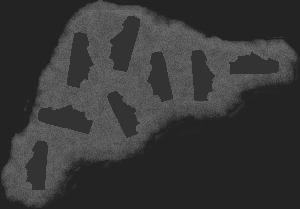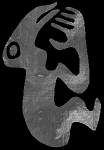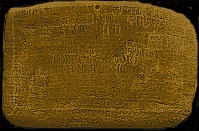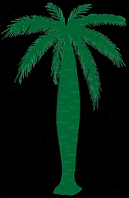 Rapa Nui's Other Mysteries |
 Within the highly stratified Rapanui culture, the Birdman Cult (tangata manu) was one of many secret societies. It may have coincided with or succeeded the statue cult. In the contest to determine the Birdman, champions of the priestly and ruling groups swam through sometimes shark-infested waters to a rocky outpost. The first to retrieve the first egg of the migratory Sooty Tern ensured his party a year as Birdman. After various ceremonies and possibly sacrifices, the Birdman, his associates, his dwelling, and his food became tapu (taboo) for many months. Within the highly stratified Rapanui culture, the Birdman Cult (tangata manu) was one of many secret societies. It may have coincided with or succeeded the statue cult. In the contest to determine the Birdman, champions of the priestly and ruling groups swam through sometimes shark-infested waters to a rocky outpost. The first to retrieve the first egg of the migratory Sooty Tern ensured his party a year as Birdman. After various ceremonies and possibly sacrifices, the Birdman, his associates, his dwelling, and his food became tapu (taboo) for many months.
|
 One of the world's most advanced neolithic (pre-metal) societies, the Rapanui had their own system of writing. Thousands of glyphs --including birds and bird-men-- were inscribed on nearly forty wooden, rongorongo tablets. Their exact purpose remains unknown, but the tablets may have been used to document ancestry, serve as a calendar, or help priests lead ceremonies. One of the world's most advanced neolithic (pre-metal) societies, the Rapanui had their own system of writing. Thousands of glyphs --including birds and bird-men-- were inscribed on nearly forty wooden, rongorongo tablets. Their exact purpose remains unknown, but the tablets may have been used to document ancestry, serve as a calendar, or help priests lead ceremonies.
|
 Rapa Nui has been looted of its treasures for centuries, and the few surviving artifacts carved in wood (often from foreign sources) and bark cloth (mahute, or tapa) are scattered in collections around the world. The earliest figures exhibit many of the traits of the Moai. Most of the figures made of bark cloth and feathers suggest the themes common to both Rapa Nui and other parts of Polynesia and Melanesia. These can be "Old Navigators" seated in canoes or mask-like images of the god Makemake (Tane) -- another bird-man symbol. Rapa Nui has been looted of its treasures for centuries, and the few surviving artifacts carved in wood (often from foreign sources) and bark cloth (mahute, or tapa) are scattered in collections around the world. The earliest figures exhibit many of the traits of the Moai. Most of the figures made of bark cloth and feathers suggest the themes common to both Rapa Nui and other parts of Polynesia and Melanesia. These can be "Old Navigators" seated in canoes or mask-like images of the god Makemake (Tane) -- another bird-man symbol.
|
 The art of dermographics was practiced throughout Oceania. Full bodily and facial tattoos were common, perhaps for the same reason as the engravings on many of the Moai. (Many static rocks also are engraved; petroglyphs of vulvae, or komari, are abundant.) A substantially greater risk of death is associated with tattooing performed with nothing sharper than a piece of coral, obsidian, or bone. Elsewhere in Polynesia the word is the same for a person getting tattooed and "victim." The art of dermographics was practiced throughout Oceania. Full bodily and facial tattoos were common, perhaps for the same reason as the engravings on many of the Moai. (Many static rocks also are engraved; petroglyphs of vulvae, or komari, are abundant.) A substantially greater risk of death is associated with tattooing performed with nothing sharper than a piece of coral, obsidian, or bone. Elsewhere in Polynesia the word is the same for a person getting tattooed and "victim."
|
 Rapa Nui has had remarkably diverse flora and fauna (much of it imported by man). Fossil evidence indicates hardwoods and a palm which was nearly identical to the rare Chilean wine palm (Jubaea chilensis). A bowed trunk is characteristic of the tree; the fruit is a small nut. The wine palm takes a long time to grow (particularly on the harsh, wind-swept island), so it is not especially surprising that the trees were wiped out. New groves of trees have been planted in recent decades. Rapa Nui has had remarkably diverse flora and fauna (much of it imported by man). Fossil evidence indicates hardwoods and a palm which was nearly identical to the rare Chilean wine palm (Jubaea chilensis). A bowed trunk is characteristic of the tree; the fruit is a small nut. The wine palm takes a long time to grow (particularly on the harsh, wind-swept island), so it is not especially surprising that the trees were wiped out. New groves of trees have been planted in recent decades.
|
For more information and a host of other Rapa Nui sites, see:Easter Island Home PagePlease do write us if you are:
|
 Previous page.
Previous page.
Hyp Records is a 3-part guide: |
Shop Hip WaxSome items above may be available at Hip Wax Hip Wax |
Hyp Records Guide © 1996 Hip Wax